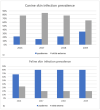On Gram-Positive- and Gram-Negative-Bacteria-Associated Canine and Feline Skin Infections: A 4-Year Retrospective Study of the University Veterinary Microbiology Diagnostic Laboratory of Naples, Italy
- PMID: 34072316
- PMCID: PMC8227065
- DOI: 10.3390/ani11061603
On Gram-Positive- and Gram-Negative-Bacteria-Associated Canine and Feline Skin Infections: A 4-Year Retrospective Study of the University Veterinary Microbiology Diagnostic Laboratory of Naples, Italy
Abstract
A 4-year retrospective study (2016-2019) of selected routine bacteriological examinations of the veterinary microbiology laboratory of the University Veterinary Teaching Hospital of Naples (Italy) was carried out. A total of 189 bacteriological samples were collected from 171 dogs and 18 cats suffering from skin infections. In dogs, the most common cutaneous infection was otitis externa, while pyoderma was found to be prevalent in cats. The number of recorded Gram-positive strains over the study period did not vary considerably from year to year and was always significantly higher (p-value = 0.0007) in comparison with Gram-negative bacterial isolations. In dogs, Staphylococcus pseudintermedius was the most common identified Gram-positive bacterium (65%), while Pseudomonas aeruginosa (36%) was the one among the isolated Gram-negative bacteria. In cats, coagulase-negative staphylococci were the most predominant isolated bacteria (47%). The phenotypic profiles of antibiotic resistance showed that most of the strains were resistant to amoxicillin-clavulanate, penicillin, clindamycin, and trimethoprim-sulfamethoxazole. Several multi-drug-resistant strains (35%) were detected in canine isolates. An updating of antibiotic resistance profiles of the main Gram-positive and Gram-negative bacteria principally associated with skin infections of pet animals is necessary to improve stewardship programs of veterinary hospitals and clinics.
Keywords: Gram-positive and Gram-negative bacteria; antibiotic resistance; pet animals; skin infections.
Conflict of interest statement
The authors declare no conflict of interest.
Figures










References
-
- De Martino L., Nocera F.P., Mallardo K., Nizza S., Masturzo E., Fiorito F., Iovane G., Catalanotti P. An update on microbiological causes of canine otitis externa in Campania Region, Italy. Asian Pac. J. Trop. Biomed. 2016;6:384–389. doi: 10.1016/j.apjtb.2015.11.012. - DOI
Grants and funding
LinkOut - more resources
Full Text Sources
Molecular Biology Databases
Miscellaneous

